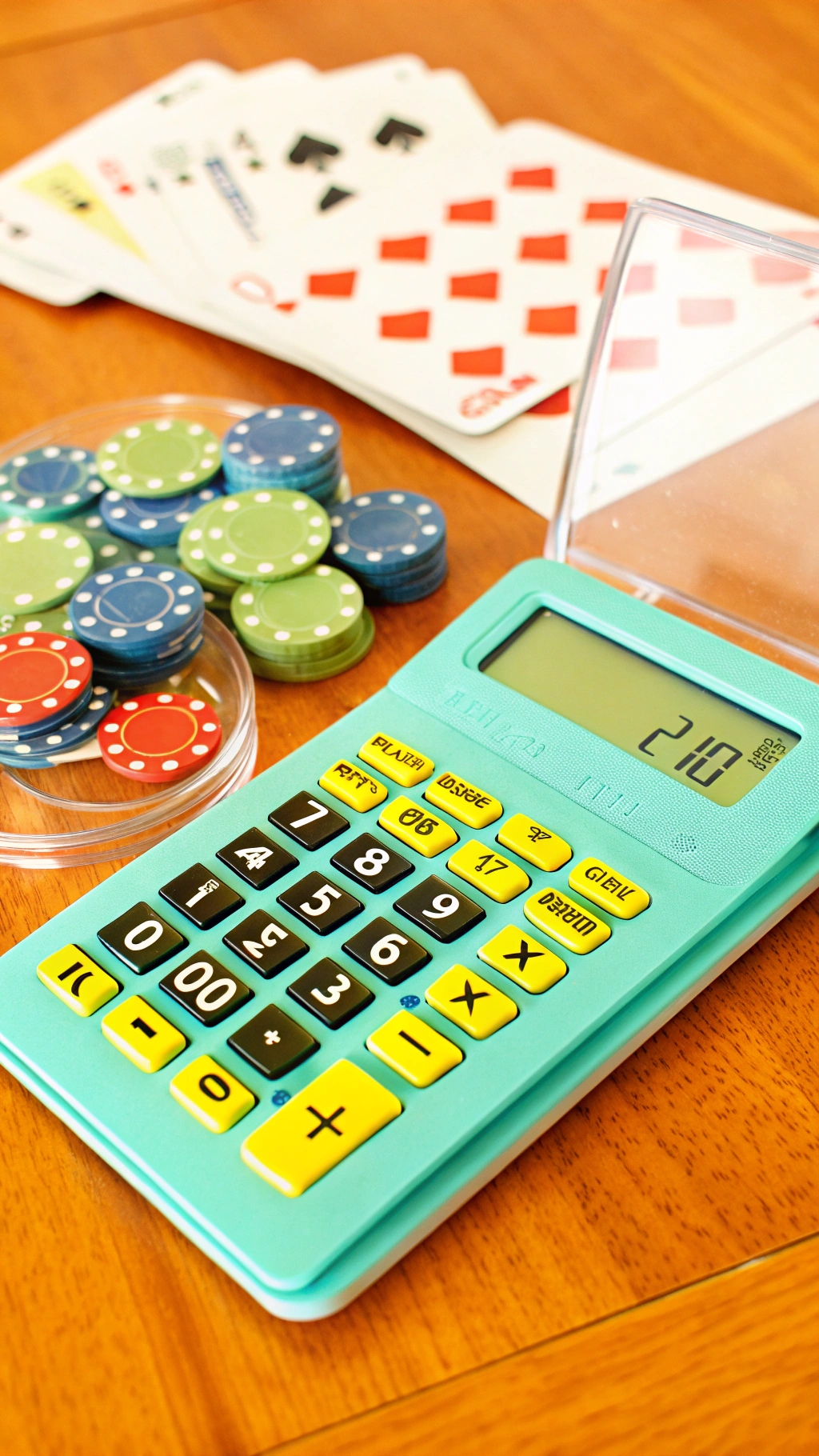Want to get better at poker? A poker odds calculator or poker equity calculator can help you make smarter moves. These tools show your chances of winning based on your cards and the table, making them great for beginners and pros in Texas Hold’em, Omaha, or other games. This guide covers what poker calculators are, why they’re useful, how they work, common myths, tips for using them, and what’s next for poker tools. We’ve included a comprehensive table of top calculators with real, working links to help you choose the best one.
What is a Poker Calculator?
A poker odds calculator is a tool that calculates your chances of winning a poker hand. It looks at your cards, community cards, and sometimes what your opponent might have. These tools started in the 2000s with online poker to help players use math to improve. For example, if you have two aces in Texas Hold’em, a poker equity calculator shows how likely you are to win against other hands.

There are different types, like poker hand calculators for checking hand strength or ICM poker calculators for tournaments. These tools have become essential for serious poker players looking to improve their game through mathematical analysis.
Why is a Poker Calculator Important?
Poker is about skill and math, not just luck. A poker equity calculator helps you decide whether to bet, call, or fold by showing your odds. Here’s why they’re useful:
Smarter Moves: Math-based decisions help you win more consistently by removing guesswork from crucial spots.
Save Money: Understanding pot odds and equity helps protect your bankroll from making costly mistakes.
Tournament Help: ICM calculators guide you in big tournament moments, like all-in decisions near the bubble.
Study Tool: Review past hands offline to identify leaks and improve your overall strategy.
Players using these tools report significant improvements in their win rates when combined with proper study and application.
How Does a Poker Calculator Work?
A poker hand calculator uses mathematical algorithms to analyze your game. Here’s how it works:
Enter Cards: Input your hole cards and any community cards that are visible.
Calculate Odds: The software checks all possible outcomes to show your win chances against opponents.
Check Pot Odds: Compares the pot size to your required bet to determine if it’s mathematically profitable.
Show Equity: A poker equity calculator tells you your percentage share of the pot in the long run.
Range Analysis: Advanced tools analyze entire hand ranges for deeper strategic insights.
For example, with a flush draw and 9 outs on the turn, a calculator might show a 19.1% chance to complete your flush on the river.
Common Misconceptions About Poker Calculators

Some myths about poker calculators can confuse players:
Myth 1: They guarantee wins. Calculators show probabilities, not certainties. Variance and skill still matter greatly.
Myth 2: Only professionals use them. Beginners can benefit significantly from simple equity calculators to learn fundamental concepts.
Myth 3: They’re cheating. Most online sites allow calculators for study purposes, but always check specific site rules for live play.
Myth 4: They make poker mechanical. Good players combine calculator insights with reads, psychology, and game flow.
Top Poker Calculators – Complete Comparison Table
| Calculator Name | Type | Best For | Key Features | Cost | Official Link |
|---|---|---|---|---|---|
| PokerNews Calculator | Free Odds Calculator | Beginners | Simple interface, Texas Hold’em focused, instant results | Free | pokernews.com/poker-tools/poker-odds-calculator |
| CardPlayer Calculator | Texas Hold’em Calculator | Hand Analysis | World’s most trusted calculator, bad beat analysis | Free | cardplayer.com/poker-tools/odds-calculator |
| CardsChat Calculator | Multi-Game Calculator | All Players | Free tool, multiple game types, easy to use | Free | cardschat.com/poker/tools/poker-odds-calculator |
| 888poker Calculator | Equity Calculator | Online Players | Real-time odds, mobile-friendly, integrated platform | Free | 888poker.com/poker/poker-odds-calculator |
| PokerCruncher | Advanced Mobile App | Mobile Users | Range vs range, multiple platforms, detailed analysis | $9.99-$29.99 | pokercruncher.com |
| GTOWizard | GTO Solver | Advanced Players | Game theory optimal solutions, AI-driven analysis | $39-$249/month | gtowizard.com |
| Flopzilla | Range Calculator | Study & Analysis | Visualize ranges, equity breakdowns, flop analysis | $25 one-time | flopzilla.com |
| ICMIZER | ICM Calculator | Tournament Players | ICM calculations, push/fold charts, bubble play | $15-$79/month | icmizer.com |
| Hold’em Manager 3 | Tracking Software | Online Grinders | Hand tracking, HUD, real-time stats, database analysis | $60-$160/year | holdemmanager.com/hm3 |
| PokerTracker 4 | Analysis Software | Serious Players | Detailed reports, HUD, leak detection, range analysis | $99.95 one-time | pokertracker.com |
| MyPokerCoaching Calculator | Free Equity Tool | Learning Players | Completely free, study-focused, educational content | Free | mypokercoaching.com/poker-odds-calculator |
| Omni Calculator | General Poker Tool | Casual Players | Web-based, no download required, basic calculations | Free | omnicalculator.com/other/poker-odds |
Practical Tips for Using Poker Calculators
Here’s how to get the most out of your poker calculator:
Choose the Right Tool: Select calculators that match your game type and skill level. Tournament players need ICM calculators, while cash game players focus on equity tools.
Practice Offline: Use calculators to review past hands and identify mistakes. This builds intuition for live play situations.
Combine with Strategy: Don’t rely solely on calculators. Integrate mathematical insights with position, opponent tendencies, and game dynamics.
Start Simple: Begin with basic odds calculators before moving to advanced GTO solvers or range analysis tools.
Mobile Accessibility: Consider mobile apps like PokerCruncher for studying away from your computer.
Regular Updates: Choose tools that receive regular updates and support current poker site changes.
Free vs. Premium Calculators
Free Options are perfect for:
- Learning basic concepts
- Casual players
- Simple hand analysis
- Students on a budget
Premium Tools offer:
- Advanced range analysis
- GTO solutions
- Tournament ICM calculations
- Professional-grade features
- Regular updates and support
Future Trends in Poker Calculators
Poker calculation tools continue evolving with new technology:
AI Integration: Modern calculators increasingly use artificial intelligence to provide more sophisticated opponent modeling and game theory solutions. Advanced NLP technologies are being integrated to better understand player behavior patterns.
Mobile-First Design: More tools are being designed specifically for mobile devices, allowing study sessions anywhere.
Real-Time Integration: Advanced tools offer simple integration with online poker platforms for immediate feedback.
Cloud-Based Solutions: Browser-based calculators eliminate the need for downloads and work across all devices.
Augmented Reality: Future calculators may overlay information directly onto live poker tables using AR technology. The integration of VR game development principles could revolutionize how poker calculators display information in immersive environments.
Blockchain Integration: With the rise of cryptocurrency gaming, Bitcoin crash games and blockchain-based poker platforms are creating new opportunities for transparent, provably fair calculator integration.
The Evolution of Poker Gaming: As discussed in the future of poker game development, modern poker platforms are becoming more sophisticated, requiring equally advanced calculator tools to keep pace with new game formats and features.
Conclusion
Poker odds calculators and equity calculators are essential tools for any serious poker player. Whether you’re a beginner learning basic concepts with free calculators like PokerNews or CardsChat, or an advanced player using sophisticated tools like GTOWizard and PokerTracker 4, these calculators provide the mathematical foundation needed for long-term success.
The key is choosing the right tool for your skill level and goals, then using it consistently to build your poker intuition. Start with free options to learn the basics, then consider premium tools as your game develops.
For those interested in developing their own poker applications or platforms, working with experienced poker game developers and utilizing professional poker software providers can help create custom calculator tools tailored to specific needs.
The gaming industry continues to evolve rapidly, with trends like battle royale games influencing how competitive gaming tools are designed and implemented across different genres, including poker.
Remember that calculators are study aids – they help you understand the math behind poker decisions, but developing strong fundamentals, reading opponents, and managing your bankroll remain crucial skills that no calculator can replace.







